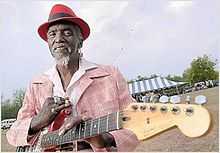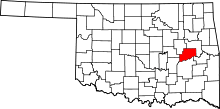Rentiesville, Oklahoma
| Rentiesville, Oklahoma | |
|---|---|
| Town | |
|
Location of Rentiesville, Oklahoma | |
| Coordinates: 35°31′31″N 95°29′31″W / 35.52528°N 95.49194°WCoordinates: 35°31′31″N 95°29′31″W / 35.52528°N 95.49194°W | |
| Country | United States |
| State | Oklahoma |
| County | McIntosh |
| Area | |
| • Total | 1.7 sq mi (4.5 km2) |
| • Land | 1.7 sq mi (4.5 km2) |
| • Water | 0.0 sq mi (0.0 km2) |
| Elevation | 600 ft (183 m) |
| Population (2010) | |
| • Total | 128 |
| • Density | 75.3/sq mi (28.4/km2) |
| Time zone | Central (CST) (UTC-6) |
| • Summer (DST) | CDT (UTC-5) |
| ZIP code | 74459 |
| Area code(s) | 539/918 |
| FIPS code | 40-62950[1] |
| GNIS feature ID | 1097165[2] |
Rentiesville is a town in McIntosh County, Oklahoma, United States. It was founded in 1903 and named for William Rentie, a local landowner. It was one of 50 all-black towns in Oklahoma and one of 13 that still survives.[3] The population was 128 at the 2010 census, an increase of 25.5 percent from 102 in 2000.[4]
History
The Civil War Battle of Honey Springs was fought about a half mile east of present-day Rentiesville and south of Oktaha, near the county line.[5] Honey Springs was Oklahoma's largest Civil War engagement.[6]
Rentiesville was founded as an all-black town in 1903 on land owned by William Rentie and Phoebe McIntosh. The post office opened May 11, 1904, and the town became a flag stop on the Missouri Kansas Texas Railroad. William Rentie was the town's only lawman until 1908, when he was shot and killed by a man he had arrested for being drunk and disorderly.[3]
In 1990, the population was 69.[7]
Geography
Rentiesville is located at 35°31′31″N 95°29′31″W / 35.52528°N 95.49194°W (35.525301, -95.491950),[8] five miles north of Checotah.[3]
According to the United States Census Bureau, the town has a total area of 1.7 square miles (4.4 km2), all land.
Demographics
As of the census[1] of 2000, there were 102 people, 42 households, and 27 families residing in the town. The population density was 59.2 people per square mile (22.9/km²). There were 51 housing units at an average density of 29.6 per square mile (11.4/km²). The racial makeup of the town was 64.71% African American, 27.45% White, 4.90% Native American, and 2.94% from two or more races.
There were 42 households out of which 21.4% had children under the age of 18 living with them, 42.9% were married couples living together, 19.0% had a female householder with no husband present, and 35.7% were non-families. 31.0% of all households were made up of individuals and 14.3% had someone living alone who was 65 years of age or older. The average household size was 2.43 and the average family size was 3.00.
In the town the population was spread out with 25.5% under the age of 18, 5.9% from 18 to 24, 23.5% from 25 to 44, 24.5% from 45 to 64, and 20.6% who were 65 years of age or older. The median age was 42 years. For every 100 females there were 92.5 males. For every 100 females age 18 and over, there were 85.4 males.
The median income for a household in the town was $23,750, and the median income for a family was $31,250. Males had a median income of $6,250 versus $36,250 for females. The per capita income for the town was $21,862. There were 26.9% of families and 24.4% of the population living below the poverty line, including 24.0% of under eighteens and 23.1% of those over 64.
Notable people

- John Hope Franklin, (1915-2009) Professor Emeritus of Duke University, historian, and author of numerous books, including "From Slavery to Freedom"[9] was born in Rentiesville. His father, B. C. Franklin, served as the second postmaster of Rentiesville.[3]
- D.C. Minner, (1935 - 2008) Blues singer, was born in Rentiesville. He owned the 'Down Home Blues Club' in Rentiesville, where he and his wife Selby Minner founded the long-running annual blues festival, the 'Dusk 'til Dawn Blues Festival'.[10]
See also
- Boley, Brooksville, Clearview, Grayson, Langston, Lima, Redbird, Summit, Taft, Tatums, Tullahassee, and Vernon, other "All-Black" settlements that were part of the Land Run of 1889.[3]
References
- ↑ 1.0 1.1 "American FactFinder". United States Census Bureau. Retrieved 2008-01-31.
- ↑ "US Board on Geographic Names". United States Geological Survey. 2007-10-25. Retrieved 2008-01-31.
- ↑ 3.0 3.1 3.2 3.3 3.4 O'Dell, Larry. Encyclopedia of Oklahoma History and Culture. Rentiesville. Accessed August 27, 2012.
- ↑ CensusViewer: Population of the City of Rentiesville, Oklahoma
- ↑ http://www.tulsaworld.com/news/article.aspx?subjectid=335&articleid=20111105_16_A15_WASHIN479818
- ↑ http://digital.library.okstate.edu/encyclopedia/entries/H/HO025.html
- ↑ "Honey Springs Battlefield Park - 1997 Master Plan Report." Hama, Karen and R. Brian Culpepper. Prepared by: The Center for Advanced Spatial Technologies, University of Arkansas, Fayetteville, Arkansas. 1997. Retrieved August 26, 2014.
- ↑ "US Gazetteer files: 2010, 2000, and 1990". United States Census Bureau. 2011-02-12. Retrieved 2011-04-23.
- ↑ Scholar Takes On His Toughest Study of Race - New York Times
- ↑ blues festival - accessed Sep 2010
| |||||||||||||||||||||||||
